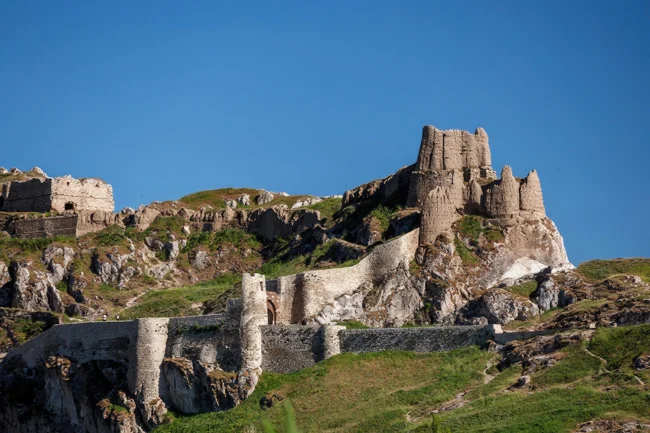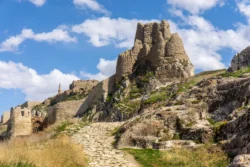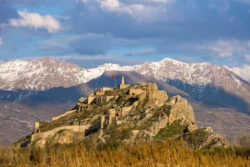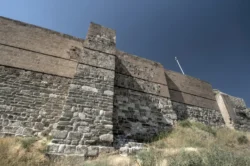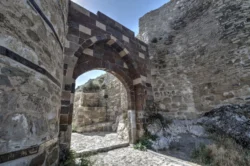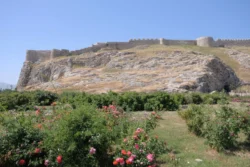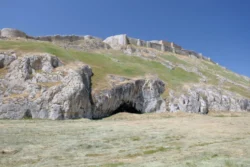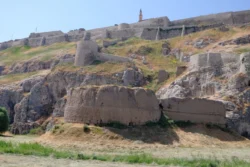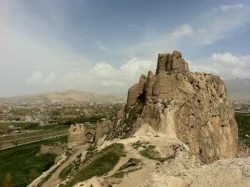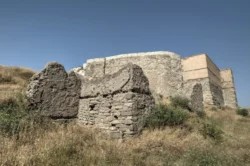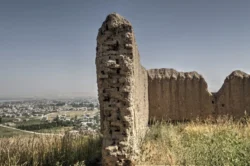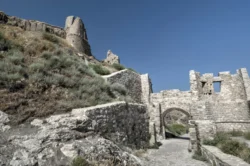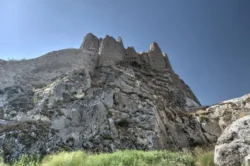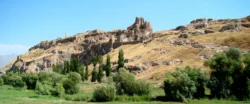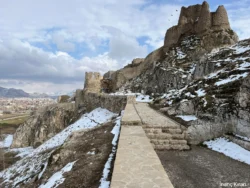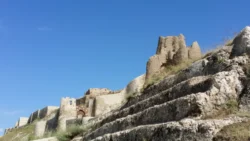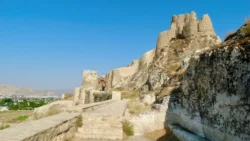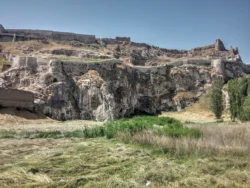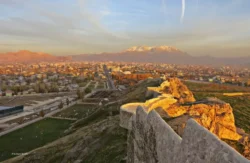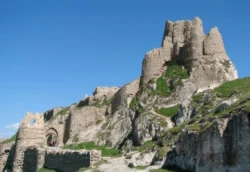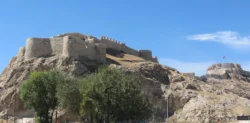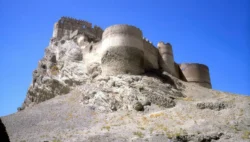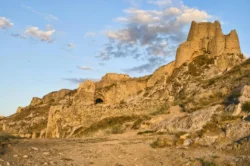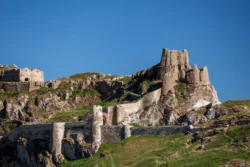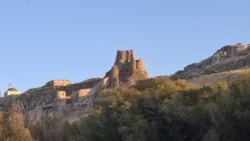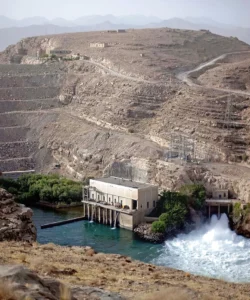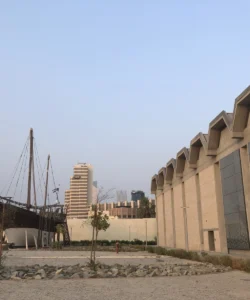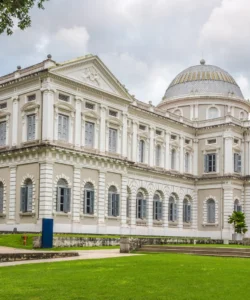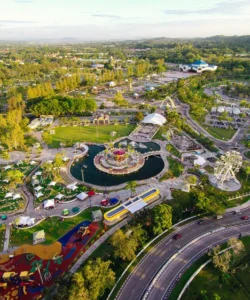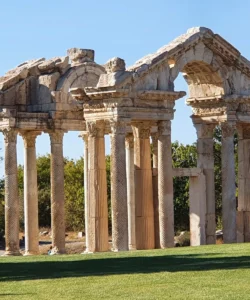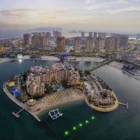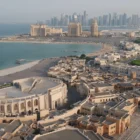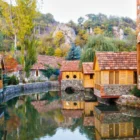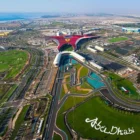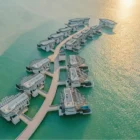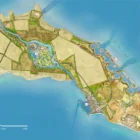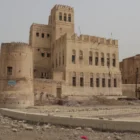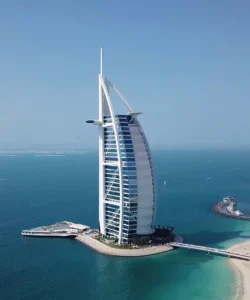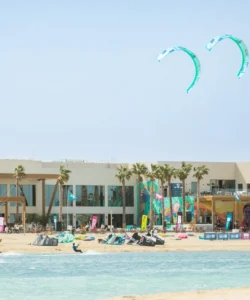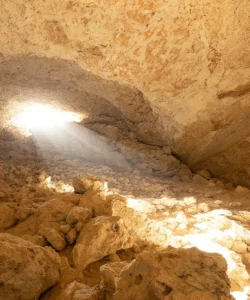Van Citadel (Turkish: Van Kalesi; Armenian: Վանի Բերդ, Vani Berd), also known as Van Fortress, is a massive stone fortification built by the ancient Kingdom of Urartu between the 9th and 7th centuries BC. It is considered the largest example of its kind and overlooks the ruins of Tushpa, the ancient Urartian capital.
Listen to an introduction about Van Citadel
Name and Address
- Name: Van Citadel (also Van Fortress, Van Kalesi, Vani Berd).
- Address: Eskişehir Mahallesi, İpekyolu İlçesi / VAN, Turkey.
- Location: Situated on a long, steep bluff (approximately 100 meters / 330 feet high) just west of the modern city of Van and east of Lake Van, in the Van Province of Eastern Anatolia, Turkey. It strategically overlooks the vast plain and the lake.
How to Get There
Van Citadel is a major historical site in Eastern Turkey and is accessible by various means:
- To Van City:
- By Plane: Van Ferit Melen Airport (VAN) is about 5 km from the city center, with daily flights from major Turkish cities like Istanbul, Ankara, and Izmir. Taxis and dolmuşes (minibuses) are available from the airport to the city.
- By Bus: Buses run regularly from major cities across Turkey, though journeys can be long (e.g., 19 hours from Ankara, 25 hours from Istanbul).
- By Train: Train services connect to Tatvan (on the western shore of Lake Van), from where you can take a bus or ferry to Van.
- To Van Citadel (from Van City Center):
- By Dolmuş (Minibus): Frequent dolmuşes marked “Kale” (Castle) run from the city center to the castle entrance. The ride takes about 20 minutes.
- Walking: On a cool day, you can walk about 3 km from the city center to the castle entrance, though there’s an additional 1.5 km walk along a lane to the official entrance.
- Taxi: Taxis are readily available for a direct ride to the citadel.
- Visitor Information:
- Entrance Fee: There is an entrance fee (e.g., 105 TL for adults as of October 2023).
- Hours: Typically open daily from 8:00 AM to 5:00 PM or 7:00 PM, depending on the season. It’s advisable to check locally for the most current hours.
Landscape and Architecture
Van Citadel is a monumental example of Urartian military architecture, built to dominate its landscape.
- Strategic Location: The fortress is built on a massive limestone cliff, approximately 1345 meters (4,413 feet) long, 200 meters (656 feet) wide, and 100 meters (330 feet) high. Its position provided unparalleled defensive advantages and commanding views of the surrounding plain and Lake Van.
- Fortification: The citadel’s walls were constructed from unmortared basalt (lower sections) and mud-bricks, rising directly from the bedrock. These formidable ramparts, often 10-12 meters high, were reinforced with rectangular buttresses and larger bastions.
- Interior Layout: The complex housed the structures of the Urartian capital, Tushpa. Key elements included:
- The Inner Castle (citadel) at the highest point, with high walls, a palace complex, and a temple.
- The Sardur Bastion at the western end, considered the earliest part of the castle, featuring important cuneiform inscriptions.
- Remains of a royal assembly hall, a temple dedicated to the Urartian god Khaldi, living quarters, dormitories, and storerooms.
- Urartian Engineering: The construction showcases sophisticated Urartian engineering, with meticulously elaborated large limestone blocks fitted tightly together without binding agents, demonstrating remarkable stability over centuries. Unique rock steps on which the ramparts rise are characteristic of Urartian architecture.
- Later Additions: Over millennia, successive empires (Medes, Achaemenids, Armenians, Parthians, Romans, Sassanids, Byzantines, Arabs, Seljuks, Safavids, Ottomans, and even Russians) controlled the fortress, leaving their marks. Notable Ottoman additions include the Süleyman Han Mosque.
- Archaeological Site: The citadel overlooks the ruins of the ancient city of Tushpa, which extended below the fortress. Archaeological excavations continue to uncover artifacts and provide insights into the various civilizations that inhabited the site.
What Makes It Famous
Van Citadel is famous for its immense historical depth, its connection to the Urartian Kingdom, and its commanding presence:
- Urartian Capital: It was the capital of the powerful ancient Kingdom of Urartu (9th-7th centuries BC), a major rival to Assyria. This makes it a crucial site for understanding one of the most significant ancient civilizations of the Near East.
- Massive Stone Fortress: It is considered the largest stone fortress of its kind, a testament to the engineering prowess of the Urartians.
- Historical Inscriptions: The site features numerous cuneiform inscriptions, including those by King Sarduri I (founder of Urartu) and Xerxes I (Achaemenid Persian king), providing invaluable historical records.
- Strategic Importance: Its strategic location made it a continuously important military and administrative center for various empires over thousands of years.
- Panoramic Views: The citadel offers breathtaking panoramic views of Lake Van and the surrounding landscape, making it a popular destination for tourists and photographers.
- Connection to Modern Van: The name of the modern city of Van is derived from this ancient fortress, highlighting a long history of continuous settlement in the area.
Differences from Other Landmarks
Van Citadel distinguishes itself from other historical sites in Armenia (and the broader region) in several ways:
- Urartian Origin and Scale: While Erebuni Fortress in Yerevan is also an Urartian site, Van Citadel was the capital of the Urartian Kingdom and represents a much larger and more complex fortified urban center. Its sheer scale and the extent of its Urartian remains are unparalleled.
- Geographical Context: Unlike Armenian sites that are primarily within modern Armenia, Van Citadel is located in Eastern Turkey, representing a significant part of the historical Armenian Highlands that now lies outside Armenia’s borders.
- Multi-Layered History: While many sites have seen successive occupations, Van Citadel’s continuous control by numerous empires (Urartian, Assyrian, Median, Achaemenid, Armenian, Roman, Byzantine, Arab, Seljuk, Ottoman, Russian) gives it an exceptionally rich and diverse historical stratification, visible in its architecture.
- Focus on Ancient Power: While Armenian monasteries (Geghard, Tatev, Noravank, Khor Virap) emphasize religious and spiritual significance, and Zvartnots an early Christian architectural innovation, Van Citadel primarily embodies ancient military and political power, serving as the heart of a vast kingdom.
- Lake Van Backdrop: Its dramatic setting directly on the shores of Lake Van (the largest lake in Turkey) provides a unique natural backdrop that enhances its grandeur, distinct from the mountain or gorge settings of many Armenian monasteries.
Van Citadel Photos:
